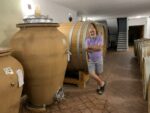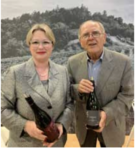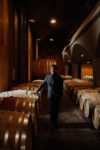Maison Camille Giroud is a former Bourgogne wine merchant whose origins date back to at least 1865.
It is indeed on this date that Mr. Camille Giroud arrives in the region to marry a young woman whose father has combined the trades of cooper and wine merchant. He took over this last trade which means that that structure already existed before this union. It’s a Maison that has remained family-owned for a very long time with a very marked style at the time, as opposed to today.
The recent history of Maison Camille Giroud was turned upside down in 2001 with the sale of the property. It was bought by a group, mainly American, of wine enthusiasts. It was for them a purchase purely of pleasure, passion and not an investment purchase. Their pleasure is to participate in a structure that makes fine wines in Burgundy and that they enjoy tasting
Let’s go together to meet this Maison and its epicurean President, Mr. Carel Voorhuis. at the table, having bottles in their cellar. It’s mostly for fun !
Why did you turn to the world of wine?
Carel Voorhuis: Even if I’m not from a wine region, it’s still a family story. My father had always been passionate about wine. He was a lawyer in the Netherlands. When he retired he sold his practice and bought some vines in the Jura area. For my part, I had started studying to become a veterinarian and I had done a few internships, but I found that wine and vines were, in my opinion, much more interesting. Finally my course in veterinary medicine ended quickly. All my scientific baggage was left to me from this experience…
Besides, originally what I liked about wine was the technique, the scientific side of wine. Today, what continues to truly fascinate me is the link between the terroir, the wine, what results from it and the alchemy that the plant brings between the two. It is only since I have been President of Maison Camille Giroud that I have been in charge of the commercial
part, of the relationship with customers and suppliers. This is a part that I also find very interesting…. It is the extension of the experience!
It is above all a passion but also an exciting and diversified career opportunity. No two working days are ever the same. It is the antiroutine par excellence. As, moreover, no two vintages are alike !
However I still keep ”one foot” in the technical aspect, production. It’s a small Maison and my training in DNO (and BTS viti-oeno) allows me to do so. I didn’t come from a business school. My role as Managing Director is important, but above all I
take care of the technical part: monitoring the vines, vines to be bought out, maturing…
Is there a common signature to the wines? A signature that helps to recognize them blind?
C.V.: I try to give way to the terroir and the raw material. The idea is to have the most faithful possible translation of the origin of the wine. So it goes, in my opinion, through the purity and elegance that is a signature of Burgundy in general. And not by oakiness or oenological subterfuges that will mark the wines. We are very natural, very local. Many of us have this desire. For me, my pride is to put my ego aside to let this terroir express itself and thus not to have a signature in the wines but a quality, a sincerity…
You talk about the natural side, the fruit side, do you have an environmental approach?
C.V.: IWe were certified organic until recently as winemakers. We had a difficult succession of vintages in Burgundy: a large number of producers decided to give themselves the chance to intervene with products not authorized as organic rather than taking unconsidered risks for their harvests. At some point, economically speaking, it becomes complicated.
Consequently, we have also put the certification aside because having two certified wines out of around thirty references does not make sense.
Technically, it didn’t change anything. Our vines are always treated according to the organic specifications as well as our vinifications. It’s all about yeasts and indigenous lactic acid bacteria. We don’t inoculate, we don’t add enzymes, we don’t sulphite during vatting. We don’t have a natural wine philosophy, but in my opinion, reducing the doses of sulfur
globally and especially during vinification makes it possible to obtain more silky, expressive wines with complexity. We therefore do it in a logic of conviction and not of certification.
You spoke to us at the beginning of this interview about a change of style in wines, could you tell us a little more?
C.V.: These were tannic wines, with great aging potential, even austere in their youth. There were very thorough extractions, long aging in barrels and when they were bottled they needed a lot of time. This was its justification in the phylloxera crisis which had been a shock for the owners of the time. The shortage of wine was unthinkable, so they wanted to have wines in their cellar that would be ready to put on the market if it happened again. The idea was therefore to make wines that could defy time and that would improve over many years. But there was never a second crisis.
Gradually consumption patterns have changed as well as consumer tastes. People with an in-house cellar who could put wines to rest for 10/15/20 years, there were also fewer and fewer of them. So the Maison gradually found itself with its cellars full
but its cash register empty. This also led to the sale of the structure… Since then, we have turned to wines with more Burgundian classicism. Today everything is vinified here too. We produce about thirty labels with a breakdown of 75% red wines and 25% white wines. It is certainly a wide range but inside there are micro-cuvées sometimes with one or three barrels.
Do you have any specific plans for the estates?
C.V.: It is difficult to project today. We would have to have a good harvest in 2022 to think about it. We will cross our fingers! There are projects but not in the short term. In the long term, we would like to grow a little more. We are currently at 120/130,000 bottles per year. The idea of going beyond tempts us, as does the extension of the range towards wines with a good quality/price ratio such as Côte Chalonnaise, Beaujolais: it’s an idea.
Thanks to Maison Camille Giroud for the welcome. – J.C.C.
Maison Camille Giroud
3 Rue Pierre Joigneaux, 21200 Beaune (France)
www.camillegiroud.com




